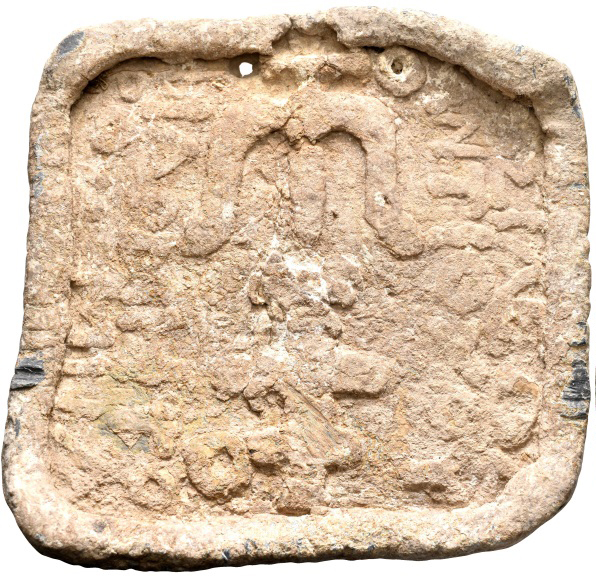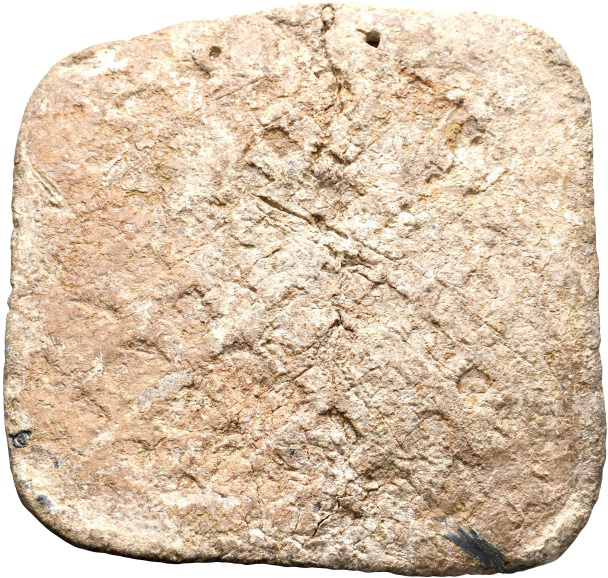
-
Copyright credit: Auction Leu 2020

-
Copyright credit: Auction Leu 2020

-
Copyright credit: Auction Leu 2020

ARCHAEOLOGICAL DESCRIPTION OF THE WEIGHT
Authority
Antiochos VIII Grypus, Seleucid King
;
Antiochos XIII Philometor, Seleucid King
Mint
Antioch
Denomination
1 Mina
Material
Lead
Manufacture
Cast
Shape
Square
Length
9.80 cm
Width
10.00 cm
Height
- cm
Metrology
| Mass (g) | Mass (grain) | Date of measurement | Reference | fragmented | cleaned | reference weight |
|---|---|---|---|---|---|---|
| 575.00 | - | - | Auction Leu 2020 | No | No | Yes |
Iconography
| Symbol | Technique | Direction | Position | Number | Synecdoche |
|---|---|---|---|---|---|
| Anchor | Relief | ||||
| Lattice pattern | Relief |
Wear
Corrosion
Handle
No
Suspension hole
Yes
Recarved mould
No
Recarved weight
No
Intentionally destroyed
No
Archaeological description
Auction Leu 2020: SELEUKID KINGS OF SYRIA. Antiochos XIII Philometor, circa 83/2–75 BC. Weight of 1 Mina (Lead, 98×100 mm, 575.00 g). BAΣIΛEΩΣ / ANTIOXOY - ΦΙΛOMHTO/POΣ MNA Seleukid anchor. Rev. Latticework design. Pondera 3521 and 3526 (attributed to either Antiochos VIII or Antiochos Philometor). Very rare and of great historical interest. Holed twice for suspension and with a flan crack, otherwise, very fine.
Autopsy
No
INSCRIPTION
| Language | Technique | Legend type |
|---|---|---|
| Greek | Relief | Authority, Denomination |
Fac simile
ΒΑΣΙΛΕΩΣ
ΑΝΤΙΟΧΟΥ
ΦΙΛΟΜΗΤΟ
ΡΟΣ ΜΝΑ
Edition
Βασιλέως | Ἀντιόχου | Φιλομήτο|ρος μνᾶ.
Monogram
ARCHAEOLOGICAL CONTEXT
Findspot (region)
Findspot (site)
context
CIRCUMSTANCES OF ACQUISITION
Region
City
Date of first acquisition
Dec. 12, 2020
circumstances
Antiquities trade.
DATING OF THE WEIGHT
Curatorial Section
GREEK
Time frame
FROM
-121
TO
-97
Comments on Chronology
Reign of Antiochus VIII Grypus (121–97 BCE).
Weiß and Ehling 2007: either Antiochus VIII (125–98/7 BCE) or another Antiochus Philometor, son of Cleopatra V Selene (92 BCE). Arguments for Antiochus VIII: typology (neither date nor name of an agoranomos on the obverse; lattice of the reverse), and the greater possibility of having conserved two weights of a 25-year reign rather than a 1-year reign. Arguments against Antiochus VIII: the use of the epithet Philometor rather than his main epithet Epiphanes. According to Weiß, the king is Antiochus VIII; according to Ehling, he is Antiochus Philometor, son of Cleopatra V Selene.
Finkielsztejn 2012: Si Antiochos VIII a initié la pratique des poids “royaux”, suivi par son (Séleucos VI assuré) ou ses fils (avec Démétrios III, non assuré), c’est lui qui est nommé ici. L’autre possibilité, choisie par les éditeurs, est Antiochos XIII (69–67 puis 65–64 a.C.), qui aurait pu poursuivre la pratique, elle-même utilisée par son père, Antiochos X (assuré par la date et l’épithète). Le poids de la mine n’est pas déterminant car, pour Antiochos VIII, nous sommes à la charnière entre les IIe et Ier s. a.C., quand une mine lourde est déjà utilisée.
Auction Leu 2020: Antiochos Philometor is only known from a handful of extremely rare coins, which show him together with his mother, the infamous Ptolemaic Queen Kleopatra Selene (SC 2484-2486), and from his lead weights, of which this is the third known example. It has been suggested that the latter should be attributed to Antiochos VIII, thus recording an otherwise unknown epithet for this king. However, this seems unlikely and this cataloguer therefore prefers to assign them Kleopatra's son, the only Antiochos whose coins record the epithet 'Philometor'. We do not know when Antiochos Philometor died, but his mother's end came in 69 BC, when she was besieged by Tigranes II 'the Great' in Ake-Ptolemais and killed shortly thereafter.
Weiß and Ehling 2007: either Antiochus VIII (125–98/7 BCE) or another Antiochus Philometor, son of Cleopatra V Selene (92 BCE). Arguments for Antiochus VIII: typology (neither date nor name of an agoranomos on the obverse; lattice of the reverse), and the greater possibility of having conserved two weights of a 25-year reign rather than a 1-year reign. Arguments against Antiochus VIII: the use of the epithet Philometor rather than his main epithet Epiphanes. According to Weiß, the king is Antiochus VIII; according to Ehling, he is Antiochus Philometor, son of Cleopatra V Selene.
Finkielsztejn 2012: Si Antiochos VIII a initié la pratique des poids “royaux”, suivi par son (Séleucos VI assuré) ou ses fils (avec Démétrios III, non assuré), c’est lui qui est nommé ici. L’autre possibilité, choisie par les éditeurs, est Antiochos XIII (69–67 puis 65–64 a.C.), qui aurait pu poursuivre la pratique, elle-même utilisée par son père, Antiochos X (assuré par la date et l’épithète). Le poids de la mine n’est pas déterminant car, pour Antiochos VIII, nous sommes à la charnière entre les IIe et Ier s. a.C., quand une mine lourde est déjà utilisée.
Auction Leu 2020: Antiochos Philometor is only known from a handful of extremely rare coins, which show him together with his mother, the infamous Ptolemaic Queen Kleopatra Selene (SC 2484-2486), and from his lead weights, of which this is the third known example. It has been suggested that the latter should be attributed to Antiochos VIII, thus recording an otherwise unknown epithet for this king. However, this seems unlikely and this cataloguer therefore prefers to assign them Kleopatra's son, the only Antiochos whose coins record the epithet 'Philometor'. We do not know when Antiochos Philometor died, but his mother's end came in 69 BC, when she was besieged by Tigranes II 'the Great' in Ake-Ptolemais and killed shortly thereafter.
COLLECTION HISTORY
Collection
| Name | Date of acquisition | Inventory number |
|---|---|---|
| Antiquities Trade | Dec. 12, 2020 | None |
Bibliography
| Reference | Page/Column | Reference (number) | Plate / Figure | Comment |
|---|---|---|---|---|
| Auction Leu 2020e | None | 905 | None | None |
| Tekin 2025a | None | None | fig. 3 | None |
VARIA